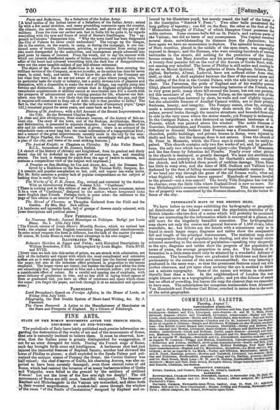FINE ARTS.
STATE OP THE ROMAN MONUMENTS AFTER THE FRENCH SIEGE, DESCRIBED BY AN EYE-WITNESS.
The periodicals of Italy have lately published such precise information re- garding the destruction of the works of art and of the monuments of Rome, that one is naturally inclined to believe them. It must be observed, how- ever, that the Italian press is greatly distinguished for exaggeration, if not for an utter disregard for truth. During the French siege of Rome, each day brought forth some sad intelligence. A barbarous shot had just injured the immortal frescoes of Raphael Sanzio; another had shivered the horse of Phidias to pieces; a shell exploded in the Spada Palace and pul- verized the antique statue of Pompey the Great; the Corsini Gallery was half ruined; the chef-d'aseivre of Guido, his charming Aurora, was also re- ported to have been severely damaged; seven those eternal rubs of old Rome, which had resisted the invasion of so many barbarous tribes of Goths and Visigoths, were felled to the ground by the artillery of civilized France! Let not the lover of the fine arts sigh too deeply! The old Monuments of Rome are still erect, beautiful, uninjured. The frescoes of Raphael and Michelangiolo in the Vatican are untouched, and shine forth in their wonted magnificence. A musket-ball came through the window of the room "of the Battle of Constantine," designed by Raphael and co- loured by his illustrious pupil, but merely erased the half of the letter in the inscription "Starnes V. Pont: ". Two other balls penetrated the long gallery of tapestry; one fell on the floor, the other at the foot of the "Miraculous Draught of Fishes," of which Hampton Court possesses the noble cartoon. Some cannon-balls fell on St. Peter's, and various parts of the Vatican; but did no harm of any consequence. The Capitol received several shots, notwithstanding its distance from the Janiculum; but here again we have no monuments to deplore. The splendid bronze statue of Marc Aurelius, placed in the middle of the open court, was especially exposed to danger; and the Romans, who were erecting hundreds of useless barricades in the streets, did nothing for the protection of the finest bronze extant; but Marc Aurelius and his proud charger escaped unhurt. A twenty-four pounder fell on the roof of the Aurora of Guido Reni, with- out causing any mischief. The horse of Phidias is still entire and rearing in the air on Mount Quirinal. The galleries of Doris Borghese, Sciarra, Ross pigliosi, Barberini, Albani, Ludovisi, have not suffered either from shot, shell, or thief. A shell exploded between the floor of the second story and the ceiling of the first in the Corsini Palace, with the sole injury- of an old chair. The Farnesina, the pride of Raphael and of his wealthy patron Ghigi, placed immediately below the breeching batteries of the French, was in very great peril; many shots fell around the house, but not one penetra. ted this sanctuary of art. The Farnese Palace, on the opposite side of the Tiber, was somewhat battered by shots, its walls and roof slightly injured; but the admirable frescoes of Annibal Cameci within, are in their pristine freshness, beauty, and integrity. The Pompey statue, close by, certainly made a miraculous escape: some thirty shots struck the walls of this palace, several broke through the massive structure, and bounded from side to side in the very room where the statue stands; yet Pompey is unharmed. In the Costiguti Palace, a shot destroyed an insignificant landscape of G. Poussin, which was painted above the window. The noble frescoes of Guercino, Dominichino, and Poussin, however, are unhurt. It must be sa- tisfactory to General Oudinot that Poussin was a Frenchman! Several churches, public buildings, and private houses in Rome, were injured by shells and balls; but the damage done is not serious. Even the church of St. Peter in Montorio, which the Times says is ruined, can be easily re- paired. This church contains only two fine works of art, and, by good for- tune, the only two which have escaped injury—the Temple of Bramante, and the fine fresco by Sebastian del Piombo. Nearly every other picture in the church is destroyed, or greatly damaged. We must not attribute the destruction here entirely to the French; for Garibaldi's soldiers occupied the church, and left behind them proofs of reckless damage. Thus, Rome has little to weep over, and the fame of MM. Oudinot and Valliant is not darkened by the dust of falling monuments of imperishable memory. But if we bend our way through the gates of the old Roman walls, what sad, what frightful, what useless havoc appears! Hundreds of houses levelled to the ground—not a tree spared! The lovely Villa Borghese has lost half its charms; even the little villa where Raphael lived is now no more. Nor was Michelarigiolo's summer retreat more fortunate. This immense sacri- fice of property was committed by the Romans themselves, for the better de- fence of the city.


























 Previous page
Previous page